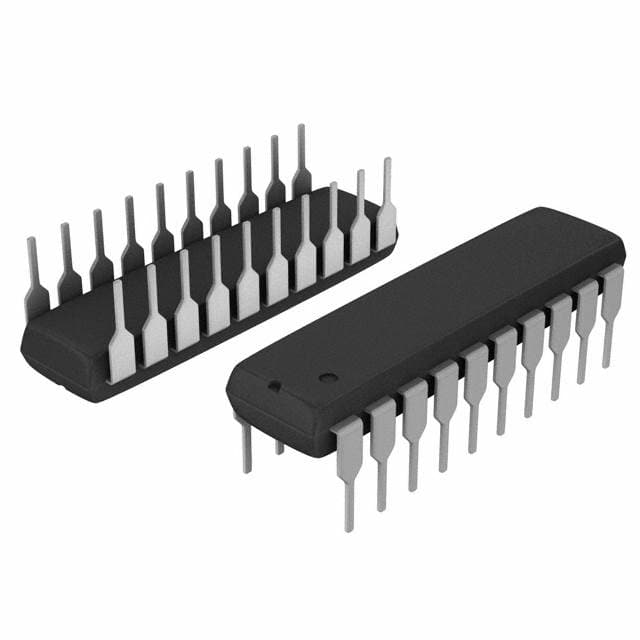AD7701BNZ
Product Overview
Category
AD7701BNZ belongs to the category of analog-to-digital converters (ADCs).
Use
The AD7701BNZ is used to convert analog signals into digital data for processing and analysis in various applications.
Characteristics
- High-resolution: The AD7701BNZ offers a resolution of up to 16 bits, ensuring accurate conversion of analog signals.
- Low power consumption: It operates on low power, making it suitable for battery-powered devices.
- Wide input voltage range: The ADC can handle input voltages ranging from -Vref to +Vref.
- Programmable gain amplifier: It includes a programmable gain amplifier that allows for amplification of weak signals.
- Serial interface: The AD7701BNZ utilizes a serial interface for communication with microcontrollers or other digital devices.
Package
The AD7701BNZ comes in a standard 24-pin DIP (Dual Inline Package) format.
Essence
The essence of the AD7701BNZ lies in its ability to accurately convert analog signals into digital data, enabling further processing and analysis.
Packaging/Quantity
The AD7701BNZ is typically packaged in tubes or trays, with quantities varying depending on the supplier.
Specifications
- Resolution: Up to 16 bits
- Input Voltage Range: -Vref to +Vref
- Supply Voltage: 2.7V to 5.25V
- Operating Temperature Range: -40°C to +85°C
- Conversion Rate: Up to 20 samples per second
- Interface: Serial (SPI)
Detailed Pin Configuration
- VDD: Power supply voltage
- VREF: Reference voltage input
- AGND: Analog ground
- AIN1(+) / AIN1(-): Differential analog input pins
- AIN2(+) / AIN2(-): Differential analog input pins
- DVDD: Digital power supply voltage
- DOUT / DIN: Serial data input/output pins
- SCLK: Serial clock input
- CS: Chip select input
- RESET: Reset input
- DRDY: Data ready output 12-24. NC: No connection
Functional Features
- High-resolution conversion: The AD7701BNZ offers a resolution of up to 16 bits, ensuring accurate representation of analog signals.
- Programmable gain amplifier: It includes a programmable gain amplifier that allows for amplification of weak signals, enhancing the overall sensitivity.
- Low power consumption: The ADC operates on low power, making it suitable for battery-powered applications.
- Serial interface: The serial interface enables easy integration with microcontrollers or other digital devices.
- Flexible input voltage range: The ADC can handle a wide range of input voltages, providing versatility in various applications.
Advantages and Disadvantages
Advantages
- High-resolution conversion ensures accurate data representation.
- Programmable gain amplifier enhances sensitivity.
- Low power consumption extends battery life.
- Serial interface simplifies integration with digital systems.
- Wide input voltage range provides flexibility.
Disadvantages
- Limited conversion rate compared to some other ADCs.
- Requires external reference voltage for accurate conversions.
Working Principles
The AD7701BNZ operates based on the successive approximation technique. It samples the analog input signal, converts it into a digital value using an internal ADC, and then outputs the result through the serial interface. The programmable gain amplifier allows for amplification of weak signals before conversion, improving the overall accuracy.
Detailed Application Field Plans
The AD7701BNZ finds applications in various fields, including:
- Industrial automation: Used for monitoring and control systems in manufacturing processes.
- Medical devices: Enables accurate measurement and analysis of physiological signals.
- Data acquisition systems: Converts analog sensor data into digital format for further processing.
- Instrumentation: Provides precise measurements in scientific instruments and test equipment.
- Automotive electronics: Used in vehicle monitoring systems and engine control units.
Detailed and Complete Alternative Models
- AD7702: Similar to AD7701BNZ but with additional features such as on-chip temperature sensor and internal reference voltage.
- ADS1115: A 16-bit ADC with a higher conversion rate and integrated programmable gain amplifier.
- MCP3208: A low-cost 12-bit ADC with SPI interface, suitable for basic applications.
- LTC2400: A high-resolution 24-bit ADC with differential inputs and I2C interface, ideal for precision measurements.
These alternative models offer different specifications and features, allowing users to choose the most suitable ADC for their specific requirements.
Word count: 615 words
רשום 10 שאלות ותשובות נפוצות הקשורות ליישום של AD7701BNZ בפתרונות טכניים
Sure! Here are 10 common questions and answers related to the application of AD7701BNZ in technical solutions:
Q1: What is AD7701BNZ? A1: AD7701BNZ is a precision analog-to-digital converter (ADC) chip manufactured by Analog Devices.
Q2: What is the resolution of AD7701BNZ? A2: AD7701BNZ has a resolution of 16 bits, meaning it can represent analog signals with 2^16 (65,536) different levels.
Q3: What is the input voltage range of AD7701BNZ? A3: The input voltage range of AD7701BNZ is programmable and can be set to either ±5V or ±10V.
Q4: How many channels does AD7701BNZ support? A4: AD7701BNZ supports two differential input channels, allowing simultaneous conversion of two analog signals.
Q5: What is the maximum sampling rate of AD7701BNZ? A5: AD7701BNZ can achieve a maximum sampling rate of 20 samples per second (SPS).
Q6: Can AD7701BNZ operate in single-ended mode? A6: No, AD7701BNZ only supports differential input mode.
Q7: Does AD7701BNZ have an on-chip reference voltage? A7: Yes, AD7701BNZ has an on-chip reference voltage generator that provides a stable reference for ADC conversions.
Q8: What is the power supply requirement for AD7701BNZ? A8: AD7701BNZ requires a single power supply voltage between 2.7V and 5.25V.
Q9: Is AD7701BNZ suitable for low-power applications? A9: Yes, AD7701BNZ is designed for low-power operation and consumes very little power during conversions.
Q10: What are some typical applications of AD7701BNZ? A10: AD7701BNZ is commonly used in various applications such as industrial process control, data acquisition systems, temperature measurement, and strain gauge amplification.
Please note that these answers are general and may vary depending on specific implementation details.


